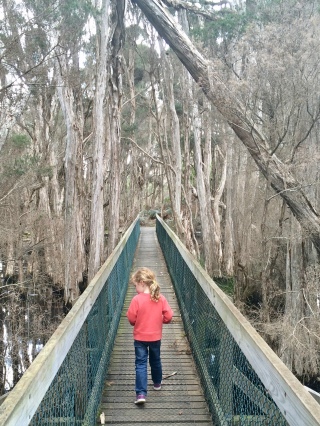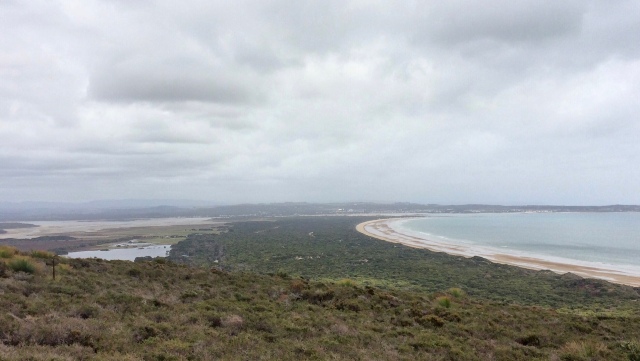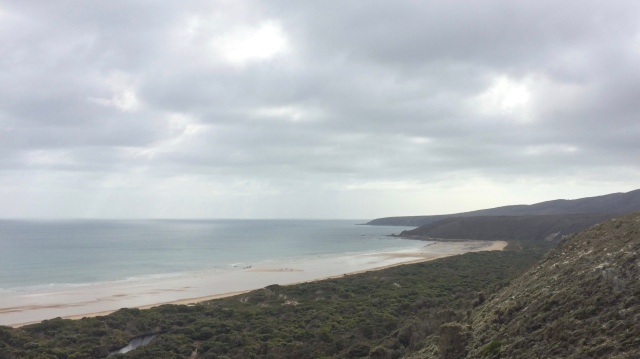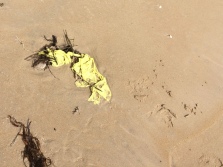There is hope, my youngest child has been enthusing about more regular adventures. When I quiz her on how long she would like the walk to be there is often a comical response, “Forty-eight-hundred-hours!” or where she would like to walk to, “New York!” We are spoilt for choice in Tasmania for walking, from easy strolls to arduous multi-day experiences. Where should I take my four year old that would be within her abilities and offer an enjoyable introduction to longer walks?
Past family outings have almost always ventured into old growth and rainforest settings (Tasmanian wilderness and beach… in a day, A West Tamar adventure). The two older kids are less enthusiastic about the great outdoors so walks have seldom gone beyond an hour. For this walk I was looking for something of about two hours duration, knowing with a small child it would likely take at least three, and without too much incline. Narawntapu National Park is on the central north coast of Tasmania, a little over an hour drive from Launceston, and has several excellent walking tracks. Archers Knob was to be our destination. At a little over 100 metres elevation and with the option to return via Bakers Beach it is perfect for young and old alike.
We checked in at the Parks and Wildlife Visitors Centre for a briefing from the Ranger on the day’s conditions. Tasmania has experienced one of its wettest winters on record (2016) so while still very manageable the track to Archers Knob has suffered some erosion. Returning via Bakers Beach is dependent on the tides as there can be very little beach to stroll along at high tide. For us it was good timing as the tide was not due to peak until late afternoon. As the weather warms up toward summer keeping an eye out for snakes is advisable. Tasmania does not do non-venomous snakes but all our other reptilian and mammalian wildlife is pretty much harmless.
 The first section of the track is in part over an elevated boardwalk through paperbark swamp to a bird hide which looks out over the Spinglawn Lagoon. There are plenty of wading birds and ducks bobbing on the water. Keep an eye out skyward also, the white bellied sea eagle while not often seen does reside in and around the national park. The sea eagle, and wedge tail eagle, are spectacular viewing, watching them soar above with wingspans that can reach over two metres.
The first section of the track is in part over an elevated boardwalk through paperbark swamp to a bird hide which looks out over the Spinglawn Lagoon. There are plenty of wading birds and ducks bobbing on the water. Keep an eye out skyward also, the white bellied sea eagle while not often seen does reside in and around the national park. The sea eagle, and wedge tail eagle, are spectacular viewing, watching them soar above with wingspans that can reach over two metres.
The coast wattle was in full bloom and wallabies regularly darted across the track in front of us as we continued on. There was a short tricky part of the track, a scramble over loose rocks and weather damaged rough ground shortly before the ascent up the hill begins. The winter rain has carved a deep rut through parts of the path as it rises up to Archers Knob. The gradient is not steep but until repairs can be made there are a few awkward spots that require care when traversing to avoid rolling an ankle.
 The view west back down to Springlawn Lagoon and Bakers Beach is most impressive from the summit while the view to the east, Little Badger Head and Badger Head, is best about halfway up. There are a couple of theories on the origin of the name Badger Head. The first is that wombats, which are in abundance in the national park, were often referred to as badgers by the British colonists hence the name. The other is the coastal features are named after Charlotte Badger, a convict, who in 1806 was being transferred from Sydney to Hobart. The story goes she lead a successful mutiny of the cargo ship Venus when it was anchored off the coast. In short, she and her crew sailed on to New Zealand where she settled in with a Maori chief for some years. The accounts vary widely that she ended up in Tonga and even perhaps made her way eventually to America on a returning whaling boat.
The view west back down to Springlawn Lagoon and Bakers Beach is most impressive from the summit while the view to the east, Little Badger Head and Badger Head, is best about halfway up. There are a couple of theories on the origin of the name Badger Head. The first is that wombats, which are in abundance in the national park, were often referred to as badgers by the British colonists hence the name. The other is the coastal features are named after Charlotte Badger, a convict, who in 1806 was being transferred from Sydney to Hobart. The story goes she lead a successful mutiny of the cargo ship Venus when it was anchored off the coast. In short, she and her crew sailed on to New Zealand where she settled in with a Maori chief for some years. The accounts vary widely that she ended up in Tonga and even perhaps made her way eventually to America on a returning whaling boat.
 After lingering for a while taking in the view and a snack it was time to head back down the hill and make our way to the beach. The track to the beach seems longer than necessary until you realise it navigates around another smaller lagoon tucked in between the dunes. The tide retreats a long way out and the beach slopes away very gently leaving a vast space for any child, or adult, to explore. My daughter’s shoes and socks were quickly discarded and her pockets were immediately being filled with shells of all shapes and colours. The skeletal remains of a porcupine fish held her attention for quite some time and a shark’s egg was a great find. There was not another soul on the beach. This is not uncommon in Tasmania.
After lingering for a while taking in the view and a snack it was time to head back down the hill and make our way to the beach. The track to the beach seems longer than necessary until you realise it navigates around another smaller lagoon tucked in between the dunes. The tide retreats a long way out and the beach slopes away very gently leaving a vast space for any child, or adult, to explore. My daughter’s shoes and socks were quickly discarded and her pockets were immediately being filled with shells of all shapes and colours. The skeletal remains of a porcupine fish held her attention for quite some time and a shark’s egg was a great find. There was not another soul on the beach. This is not uncommon in Tasmania.
It was a very leisurely stroll back along the beach. From the beach back to the Visitors Centre is via the (unsealed) road and someone was reluctant to put their shoes back on. It was only a few hundred metres so she climbed onto my back and her walking was done for the day. We stopped to watch kangaroos grazing and even a few wombats. By the time we reached the car we had been out and about for almost four hours, an idyllic four hours. We’ll be back again soon no doubt.
Further reading if you haven’t already: Narawntapu National Park (Part 1) – some history.
Map and directions from Launceston.
Map and directions from the Spirit of Tasmania Ferry Terminal Devonport.
Facilities, walking tracks and activities at Narawntapu National Park.
* * *
 Pick up some flotsam…
Pick up some flotsam…
Tasmania’s beaches and coastline are predominantly unspoiled. It is important they remain this way, not only for the native wildlife inhabitants but also for our enjoyment too. Plastic is the biggest challenge our shorelines face. Whether it be by accident or carelessness it is turning up on our beaches. I urge anyone and everyone to pick up a piece of flotsam as you leave from your day or weekend at the beach and find a bin for proper disposal.




We’d sure like to walk like you too in Tasmania!
Pingback: Narawntapu National Park (Part 1) – some history. | Simon McInerney